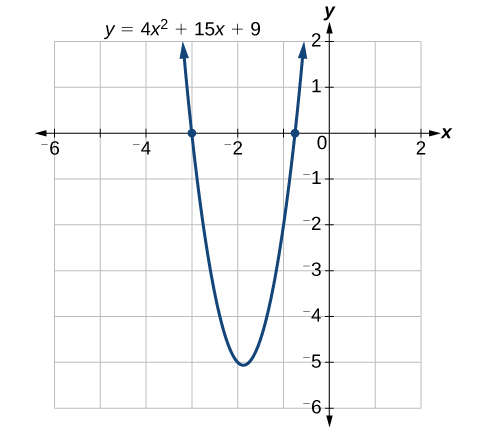- Solve quadratic equations using factoring and grouping
An equation containing a second-degree polynomial is called a quadratic equation. For example, equations such as [latex]2{x}^{2}+3x - 1=0[/latex] and [latex]{x}^{2}-4=0[/latex] are quadratic equations. They are used in countless ways in the fields of engineering, architecture, finance, biological science, and, of course, mathematics.
Often the easiest method of solving a quadratic equation is factoring. Factoring a quadratic equation involves expressing it as a product of simpler polynomials, typically two binomials.
If a quadratic equation can be factored, it is written as a product of linear terms. Solving by factoring depends on the zero-product property which states that if [latex]a\cdot b=0[/latex], then [latex]a=0[/latex] or [latex]b=0[/latex], where a and b are real numbers or algebraic expressions. In other words, if the product of two numbers or two expressions equals zero, then one of the numbers or one of the expressions must equal zero because zero multiplied by anything equals zero.
Multiplying the factors expands the equation to a string of terms separated by plus or minus signs. So, in that sense, the operation of multiplication undoes the operation of factoring.
The product is a quadratic expression. Set equal to zero, [latex]{x}^{2}+x - 6=0[/latex] is a quadratic equation. If we were to factor the equation, we would get back the factors we multiplied.
The process of factoring a quadratic equation depends on the leading coefficient, whether it is 1 or another integer.
- Find two numbers whose product equals c and whose sum equals [latex]b[/latex].
- Use those numbers to write two factors of the form [latex]\left(x+k\right)\text{ or }\left(x-k\right)[/latex], where [latex]k[/latex] is one of the numbers found in step 1. Use the numbers exactly as they are. In other words, if the two numbers are [latex]1[/latex] and [latex]-2[/latex], the factors are [latex]\left(x+1\right)\left(x - 2\right)[/latex].
- Solve using the zero-product property by setting each factor equal to zero and solving for the variable.
[latex]x^2+x - 6 = (x+2)(x-3)[/latex]
Step 2: Apply the Zero-Product Property to find [latex]x[/latex].
[latex]\begin{align*} \text{Equation:} && x^2 + x - 6 &= 0 \\ \text{Factored form:} && (x - 2)(x + 3) &= 0 \\ \text{Apply zero product property:} && x - 2 &= 0 \quad \text{or} \quad x + 3 = 0 \\ \text{Solution:} && x &= 2 \quad \text{or} \quad x = -3 \end{align*}[/latex]
When the leading coefficient is not [latex]1[/latex], we factor a quadratic equation using the method called grouping, which requires four terms.
- With the quadratic in standard form, [latex]ax^2 + bx + c = 0[/latex], multiply [latex]a \cdot c[/latex].
- Find two numbers whose product equals [latex]a \cdot c[/latex] and whose sum equals [latex]b[/latex].
- Rewrite the equation replacing the [latex]bx[/latex] term with two terms using the numbers found in step 2 as coefficients of [latex]x[/latex].
- Factor the first two terms and then factor the last two terms. The expressions in parentheses must be exactly the same to use grouping.
- Factor out the expression in parentheses.
- Set the expressions equal to zero and solve for the variable.
